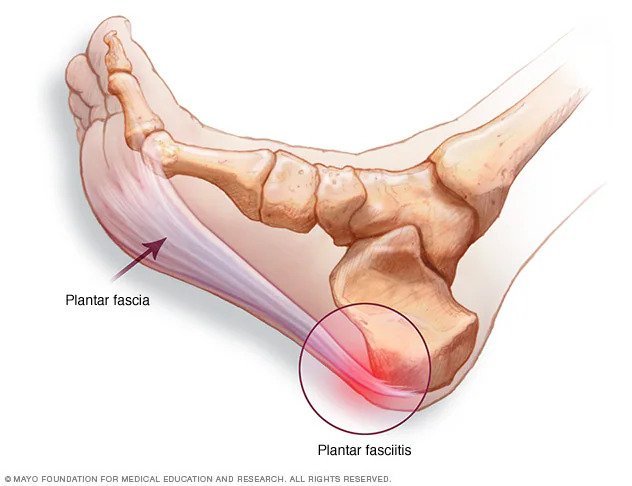The difference between Plantar Fasciitis and Plantar Aponeurosis: What you need to know
Plantar fasciitis and plantar aponeurosis are two common treatments in our chiropractic space. Unfortunately, these treatments are frequently confused because they have similar symptoms. However, to receive proper treatment, it is critical to understand the differences between the two conditions.
Our blog uncovers the distinctions between plantar fasciitis and plantar aponeurosis.
What is Plantar Fasciitis?
Plantar fasciitis is a painful condition that affects the heel and sole of the foot. Plantar fasciitis is when the plantar fascia, a thick band of tissue that runs along the bottom of the foot, becomes inflamed or damaged, causing heel pain.
Plantar fasciitis can occur from many factors, including as a result of overuse, wearing shoes with inadequate arch support, or standing for long periods of time on hard surfaces.
Research states that plantar fasciitis is commonly caused by the repetitive overuse of the plantar fascia, which may result from activities such as running, jumping, or walking on hard surfaces. Risk factors that contribute to this condition include obesity, flat feet, and wearing inappropriate footwear.
Image of Plantar Fasciitis (Photo credit Mayo Clinic)
The symptoms of plantar fasciitis include:
● Pain in the heel and bottom of the foot
● Stiffness and tenderness in the foot
● Pain that is worse in the morning or after long periods of sitting or standing
Plantar fasciitis treatment may include:
● Resting and avoiding painful activities
● Heat applied to the affected area
● Exercises for stretching and strengthening
● Wearing shoes that provide adequate arch support
● Making use of orthotic devices such as heel cups or shoe inserts
● Visiting a Chiropractor for Shockwave therapy
What is Plantar Aponeurosis?
Plantar aponeurosis, also known as plantar fascia, is a thick, fibrous band of tissue that runs along the bottom of the foot, connecting the heel bone to the toes. Unlike plantar fasciitis, which is an inflammatory condition, plantar aponeurosis is a structural condition that occurs when the plantar aponeurosis becomes thickened and less flexible.
Researchers Lemont et al. (2003) conducted a study which revealed that chronic heel pain is frequently attributed to plantar aponeurosis and is often accompanied by a history of plantar fasciitis. The research concluded the condition can arise from repetitive stress, biomechanical abnormalities, or degenerative modifications in the plantar fascia.
Image of the foot showing Plantar Aponeurosis (photo credit researchgate)
The symptoms of plantar aponeurosis include:
● Foot pain and stiffness in the arch
● Standing on tiptoe might be difficult.
● A tightening or stiffening sensation in the foot
Plantar aponeurosis treatment options include:
● Exercises for stretching and strengthening
● Utilizing orthotic items like arch supports and shoe inserts
● Rehabilitation treatment from Chiropractors
● In extreme circumstances, surgery may be required.
What are the Differences Between Plantar Fasciitis and Plantar Aponeurosis?
The primary distinction between plantar fasciitis and plantar aponeurosis is the source of the ailment. Plantar fasciitis is an inflammatory disorder caused by plantar fascia irritation or injury. On the other hand, plantar aponeurosis is a structural problem caused by plantar aponeurosis thickness and lack of flexibility.
The symptoms of the two conditions slightly differ as well. For example, Plantar fasciitis is characterized by pain in the heel and sole of the foot. In contrast, plantar aponeurosis is characterized by pain and stiffness in the foot's arch. Also, plantar fasciitis is generally worse in the morning or after extended hours of sitting or standing, whereas plantar aponeurosis may make standing on tiptoe difficult.
In conclusion, while plantar fasciitis and plantar aponeurosis may present with similar symptoms, they are distinct illnesses requiring distinct treatment techniques. Therefore, if you have foot pain or discomfort, getting medical guidance from a healthcare expert is essential to receive the correct diagnosis and treatment.
How does Shockwave therapy help plantar fasciitis?
Shockwave Therapy can help in the alleviation of the symptoms of plantar fasciitis. The shockwave therapy machine transmits a strong energy pulse throughout your foot. These energy pulses break down the scar tissue buildup, reduce inflammation, and stimulate regeneration. As a result, your blood circulation increases in the treated area(s), which triggers your body's natural healing process.
A 2021 study suggests that shockwave therapy is an effective treatment for plantar fasciitis. Research has found that after four sessions of shockwave therapy, the thickness of the planar fascia had been reduced, including the symptoms of inflammation.
Patients who receive shockwave therapy for plantar fasciitis find relief and experience a dramatic reduction in their pain. If you are looking for more information about shockwave therapy, you can visit our page here. If you are experiencing foot pain, you can book a consultation session with Dr. Chris or Dr. Lauren to see if shockwave therapy is right for you.



